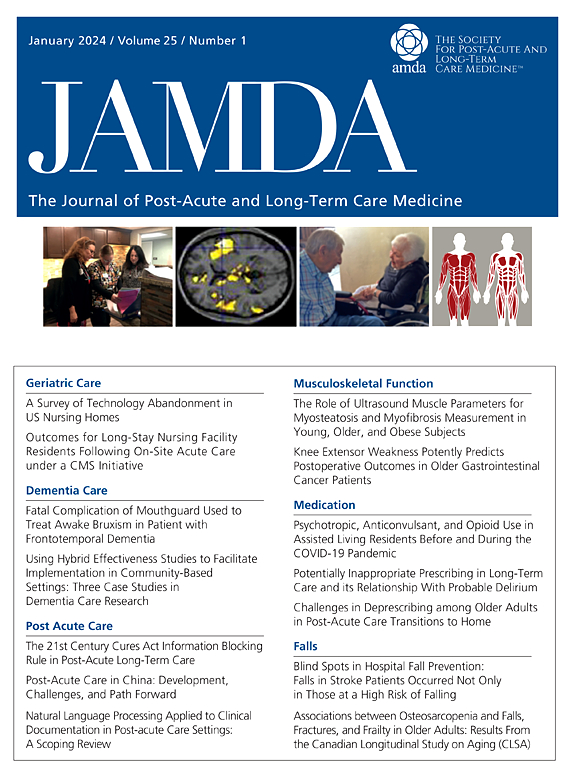Transitions to Nursing Homes among Residents of Assisted Living and Community-Dwelling Home Care Recipients
IF 4.2
2区 医学
Q2 GERIATRICS & GERONTOLOGY
Journal of the American Medical Directors Association
Pub Date : 2025-02-01
DOI:10.1016/j.jamda.2024.105429
引用次数: 0
Abstract
Objectives
To examine transitions to a nursing home among residents of assisted living relative to community-dwelling home care recipients.
Design
Population-based retrospective cohort study emulating a target trial.
Setting and Participants
Linked, individual-level health system data were obtained from older adults (aged ≥65 years) who made an incident application for a bed in a nursing home in Ontario, Canada, between April 1, 2014, and March 31, 2019, and were followed until December 31, 2019.
Methods
Residency in assisted living was compared with only community-dwelling home care. Any long-stay (≥90 days) and short-stay (<90 days) transitions to a nursing home were examined. Inverse probability weighted pooled logistic regression models were used to generate marginal cumulative incidence curves under each exposure status that were standardized by the covariates.
Results
This study included 10,012 residents of assisted living [mean (SD) aged 88.7 (6.26) years, 75% female] and 131,679 home care recipients [mean (SD) aged 84.8 (7.43) years, 63% female] who applied for a bed in a nursing home (N = 141,691; 95,744.6 person-years). There were 6049 transitions among applicants from assisted living and 85,190 transitions among applicants who were home care recipients to a nursing home. The 5-year absolute risk reduction was 110 transitions to a nursing home per 1000 older adult applicants if all applicants resided in assisted living (95% CI, 71–148). Residency in assisted living resulted in a 12.7% relative decrease in the 5-year risk of any transition to a nursing home had all applicants resided in assisted living (95% CI, 8.3%–17.1%).
Conclusions and Implications
Residents of assisted living were less likely to transition to a nursing home, despite equivalent clinical complexity and health care needs. The integration of assisted living into the continuum of care from the community to institutionalized nursing homes would better inform health system capacity and planning.
辅助生活及社区居住家庭护理接受人向疗养院的过渡。
目的:研究辅助生活的居民相对于社区居住的家庭护理接受者向养老院的过渡。设计:以人群为基础的回顾性队列研究,模拟目标试验。环境和参与者:从2014年4月1日至2019年3月31日期间在加拿大安大略省养老院申请床位的老年人(≥65岁)中获得相关的个人卫生系统数据,并随访至2019年12月31日。方法:将住院辅助生活与单纯的社区居家护理进行比较。结果:本研究纳入10012名在养老院申请床位的辅助生活居民(平均[SD]年龄88.7[6.26]岁,75%为女性)和131679名居家护理接受人(平均[SD]年龄84.8[7.43]岁,63%为女性)(N = 141691;95744。6组)。有6049名申请人从辅助生活转到养老院,85190名申请人从家庭护理转到养老院。如果所有申请人都居住在辅助生活中,每1000名老年人申请者中,5年绝对风险降低为110人转到养老院(95% CI, 71-148)。居住在辅助生活中导致所有申请人居住在辅助生活中,任何过渡到养老院的5年风险相对降低12.7% (95% CI, 8.3%-17.1%)。结论和意义:尽管临床复杂性和医疗保健需求相同,但辅助生活的居民不太可能过渡到养老院。将辅助生活纳入从社区到机构养老院的连续护理中,将更好地为卫生系统的能力和规划提供信息。
本文章由计算机程序翻译,如有差异,请以英文原文为准。
求助全文
约1分钟内获得全文
求助全文
来源期刊
CiteScore
11.10
自引率
6.60%
发文量
472
审稿时长
44 days
期刊介绍:
JAMDA, the official journal of AMDA - The Society for Post-Acute and Long-Term Care Medicine, is a leading peer-reviewed publication that offers practical information and research geared towards healthcare professionals in the post-acute and long-term care fields. It is also a valuable resource for policy-makers, organizational leaders, educators, and advocates.
The journal provides essential information for various healthcare professionals such as medical directors, attending physicians, nurses, consultant pharmacists, geriatric psychiatrists, nurse practitioners, physician assistants, physical and occupational therapists, social workers, and others involved in providing, overseeing, and promoting quality

 求助内容:
求助内容: 应助结果提醒方式:
应助结果提醒方式:


